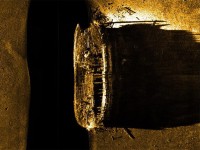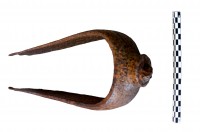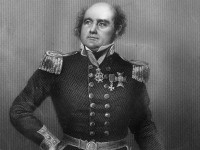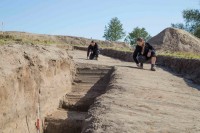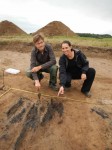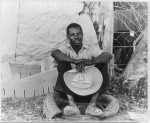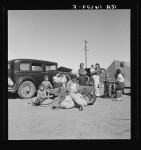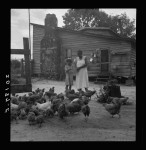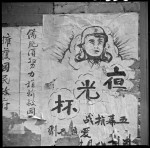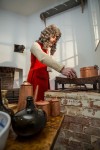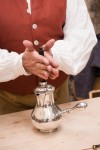 The Christie’s Out of the Ordinary auction held in London on September 3rd offered an eclectic array of objects, to say the least. A pair of Victorian taxidermy red squirrels playing cards rubbed shoulders with an Enigma machine and a framed 1746 map of London 12’7″ wide.
The Christie’s Out of the Ordinary auction held in London on September 3rd offered an eclectic array of objects, to say the least. A pair of Victorian taxidermy red squirrels playing cards rubbed shoulders with an Enigma machine and a framed 1746 map of London 12’7″ wide.
The lead item in the sale was a late medieval broadsword with an illustrious history. The blade is of Viking manufacture. It was captured by the English at the Battle of Stamford Bridge on September 25th, 1066, three weeks before the Battle of Hastings. It’s not certain what road it took after that, but by the 13th century it was in the hands of the de Bohun family. Since the first Humphrey de Bohun in England was a Norman nobleman who fought by William the Conqueror’s side at the Battle of Hastings, it’s possible he acquired the Viking sword on the field at Hastings.
![]() What’s certain is that a few centuries later, the Viking blade had been remounted with the de Bohum coat of arms in gold and enamel on the pommel. Sir Humphrey de Bohun, 4th Earl of Hereford and Essex, fought at the Battle of Bannockburn in 1314, this time on the losing side. His nephew was killed by King Robert’s own hand and Sir Humphrey was taken captive. He would be exchanged for King Robert’s wife. daughter and a handful of other important Scots. The sword probably wasn’t used on the field at Bannockburn as it wasn’t au courant for mounted combat, but it could have been with Sir Humphrey as a side arm in camp. The broadsword is mentioned in his will just five years later.
What’s certain is that a few centuries later, the Viking blade had been remounted with the de Bohum coat of arms in gold and enamel on the pommel. Sir Humphrey de Bohun, 4th Earl of Hereford and Essex, fought at the Battle of Bannockburn in 1314, this time on the losing side. His nephew was killed by King Robert’s own hand and Sir Humphrey was taken captive. He would be exchanged for King Robert’s wife. daughter and a handful of other important Scots. The sword probably wasn’t used on the field at Bannockburn as it wasn’t au courant for mounted combat, but it could have been with Sir Humphrey as a side arm in camp. The broadsword is mentioned in his will just five years later.
Expectations for this sword were high, with a pre-sale estimate of £80,000 – 120,000 ($129,584 – 194,376). Expectations were dashed when this historically significant weapon failed to sell.
 A 19th century vibrator, on the other hand, exceeded expectations. Only slightly used — the condition report describes the exterior as having “some light wear, scuffing and scratches, consistent with age” — it sold above estimate at £1,625 ($2,675). It’s actually quite ingenious, made out of celluloid and white metal by Dr. Benjamin Y. Boyd who patented it in 1893 under the suitably vague title of “electrical instrument for medical purposes.”
A 19th century vibrator, on the other hand, exceeded expectations. Only slightly used — the condition report describes the exterior as having “some light wear, scuffing and scratches, consistent with age” — it sold above estimate at £1,625 ($2,675). It’s actually quite ingenious, made out of celluloid and white metal by Dr. Benjamin Y. Boyd who patented it in 1893 under the suitably vague title of “electrical instrument for medical purposes.”
He minces no words at all in the body of the patent application, however. The device is an “improved electrical, urethral, vaginal, and rectal vitalizer” and check out how it’s powered:
It is composed of alternate cylinders of zinc and celluloid or other insulating substance, and silver, copper or other metal, so connected with a fluid, either acid, alkaline or neutral, on the inside of the combined cylinder, and moisture or secretions from the mucous membranes from the body, on the outside of said cylinder, as to form a series of electric batteries, when introduced into a mucous cavity, thus forming or producing a voltaic current of electricity at each cell. Each of these cells consists of three cylinders, a negative and positive element A O, separated by an insulator B. The current passes from a cylinder of one element through the affected part, to the cylinder of the opposite element.
 That’s a lot of progress since Dr. George Taylor invented his steam-powered Manipulator 24 years earlier. Dr. Boyd kept the improvements coming, to coin a phrase, receiving another patent in 1895 for two versions of the “electrical instrument for medical purposes,” one a version of the 1893 device, the other with a dedicated rectal function.
That’s a lot of progress since Dr. George Taylor invented his steam-powered Manipulator 24 years earlier. Dr. Boyd kept the improvements coming, to coin a phrase, receiving another patent in 1895 for two versions of the “electrical instrument for medical purposes,” one a version of the 1893 device, the other with a dedicated rectal function.
 In 1909 he gave male genitalia their chance at an electrotherapeutic apparatus. It consists of two cups, one shaped to fit the scrotum and the other the penis, that were filled with plain or medicated water (God knows what kind of medication he had in mind) and had a current sent through them. This would treat varicoceles and “diminished vigor” by “contracting the varicose veins and dilating the dorsa and other veins of the penis, thus curing the varicocele and restoring the natural vigor simultaneously.”
In 1909 he gave male genitalia their chance at an electrotherapeutic apparatus. It consists of two cups, one shaped to fit the scrotum and the other the penis, that were filled with plain or medicated water (God knows what kind of medication he had in mind) and had a current sent through them. This would treat varicoceles and “diminished vigor” by “contracting the varicose veins and dilating the dorsa and other veins of the penis, thus curing the varicocele and restoring the natural vigor simultaneously.”
I wasn’t able to discover much of anything about the dedicated Dr. Boyd, but there is this juicy tidbit in a 1909 issue of the Illinois Medical Journal:
It is reported that Mrs. Leopoldine Boyd has filed a bill for divorce against her husband, Dr. Benjamin Y. Boyd, a Chicago physician, alleging that he had deserted the complainant and was living with another woman.
Why Dr. Boyd, you dirty dog, you.
